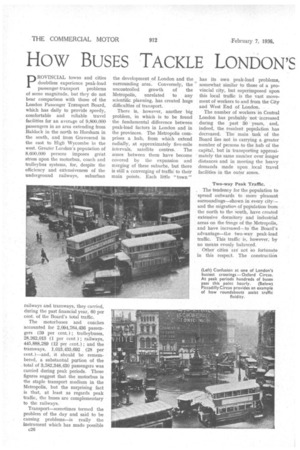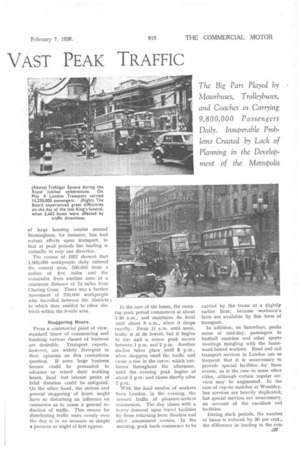How BUSES TACKLE LONDON'S VAST PEAK TRAFFIC
Page 80

Page 81

Page 82

If you've noticed an error in this article please click here to report it so we can fix it.
pROVINCIAL towns and cities doubtless experience peak-load passenger-transport problems of some magnitude, but they do not bear comparison with those of the London Passenger Transport Board, which has daily to provide speedy, comfortable and reliable travel facilities for an average of 9,800.000 passengers in an area extending from Baldock in the north to Horsham in the south, and from Gravesend in the east to High Wycombe in the west. Greater London's population of 8,600,000 persons imposes great stress upon the motorbus, coach and trolleybus systems, for, despite the efficiency and eittensiveness of the underground railways, suburban
railways and tramways, they carried, during the past financial year, 60 per cent. of the Board's total traffic.
The motorbuses and coaches accounted for 2,094,764,436 passengers (59 per cent.) ; trolleybuses, 28,262,013 (1 per cent ) ; railways, 445,888,289 (12 per cent.) ; and the tramways, 1,013,433,692 (28 per cent.)—and, it should be remembered, a substantial portion of the total of 3,582,348,430 passengers was carried during peak periods. These figures suggest that the motorbus is the staple transport medium in the Metropolis, but the surprising fact is that, at least as regards peak traffic, the buses are complementary to the railways.
Transport—sometimes termed the problem of the day and said to be causing problems—is really the instrument which has made possible c26 the development of London and the surrounding area. Conversely, the uncontrolled growth of the Metropolis, unrelated to any scientific planning, has created huge difficulties of transport.
There is, however, another big problem, in which is to be found the fundamental difference between peak-load factors in London and in the provinces. The Metropolis comprises a hub, from which extend radially, at approximately five-mile intervals, satellite centres. The zones between them have become covered by the expansion and merging of these suburbs, but there is still a converging of traffic to their main points. Each little "town" has its own peak-load problems, somewhat similar to those of a provincial city, but superimposed upon this local traffic is the vast movement of workers to and from the City and West End of London.
The number of workers in Central London has probably not increased during the past 30 years, and, indeed, the resident population has decreased. The main task of the Board lies not in carrying a greater number of persons to the hub of the capital, but in transporting approximately the same number over longer distances and in meeting the heavy demands made upon local travel facilities in the outer zones.
Two-way Peak Traffic.
The tendency for the population to spread outwards to more pleasant surroundings—shown in every city:— and the migration of population from the north to the south, have created extensive dormitory and industrial areas on the fringe of the Metropolis, and have increased—to-the Board's advantage—the two-way peak-load traffic. This traffic is, however, by no means evenly balanced.
Other cities are not so fortunate in this respect. The construcfion of large housing estates around Birmingham, for instance, has had serious effects upon transport, in that at peak periods the loading is virtually in only one direction., The census of 1921 showed that 1,000,000 workpeople daily entered the central area, 500,000 from a radius of five miles and the remainder from another zone at a minimum distance of 7i miles from Charing Cross. There was a further movement of 750,000 workpeople who travelled between the districts in which they resided to other districts within the 5-mile area.
Staggering Hours.
From a commercial point of view, standard times of commencing and finishing various classes of business are desirable. Transport experts, however, are widely divergent in their opinions on this contentious question. If some large business houses could be persuaded to advance 'or retard their working hours, local but intense peaks of brief duration could be mitigated. On the other hand, the serious and general staggering of hours might have so disturbing an influence on commerce as to cause a general reduction of traffic. This means for distributing traffic more evenly over the day is in no measure so simple a panacea as might at first appear. In the case of the buses, the morning peak period commences at about 7.30 a.m., and maintains its level until about 9 a.m., when it drops rapidly. From 11 a.m. until noon, traffic is at its lowest, but it begins to rise and a minor peak -occurs between 1p.m. and 2 p.m. Another decline takes place until 3 p.m., when shoppers swell the traffic and cause a rise in the curve, which continues throughout the afternoon, until the evening peak begins at about 5 p.m. and closes shortly after 7 p.m.
With the final exodus of workers from London, in the evening, the inward traffic of pleasure-seekers commences. The day closes with a heavy demand upon travel facilities by those returning from theatres and other amusement centres. In the morning, peak loads commence to be carried by the trams at a slightly earlier hour, because workmen's fares are available by this form of transport.
In addition, on Saturdays, peaks occur at mid-day, passengers to football matches and other sports meetings mingling with the homeward-bound workers. Road and rail transport services in London are so frequent that it is unnecessary to provide special facilities for these events, as is the case in some other cities, although certain regular services may be augmented. In the case of cup-tie matches at Wembley, bus services are heavily duplicated, but special services are unnecessary, on account of the excellent rail facilities.
During slack periods, the number of buses is reduced by 20 per cent., the difference in loading in the cen27 tral area being about 40 per cent, of seating capacity as between peak and slack hours, and 50 per cent. in the suburbs. Tram services are cut by about 35 per cent.
The lack of planning in the development of the capital has re suited in the City streets reaching saturation point in traffic-bearing capacity, whilst the West End thoroughfares are rapidly approaching that condition, and vehicle movement over a wide area will soon be affected. The increase in traffic, between 1923 and 1933, in the outer areas, corresponds with the rise in the central zone, and one cannot expect any improvement in the average speed of transport across London.
There are no trams in the central area, but, even so, the average speed of bus operation in parts of it is re deiced to about 6.5 m.p.h., as compared with 12 m.p.h. in the outer districts. The average speed might be even lower in the absence of roundabouts at many important road junctions, which, although they incur an additional bus mileage of 3,500 a day (theoretically the equivalent of work for 26 additional buses), are justified by the saving in time effected by improved fluidity. This figure appears, at first sight, to be scarcely believable, but one has to remember that an average of 5,000 buses is in operation daily, covering a total mileage of 700,000.
An experiment being carried out by the Board of fixing stopping places (about six per mile) on certain routes, between which the picking up and setting down of passengers is prohibited, should speed up peakload operation.
c28 Even with speed at the present generally low level, however, buses provide accommodation for nearly 20,000 persons per hour, during peak periods, in the heavily congested part of Oxford Street between Oxford Circus and Bond Street. The maximum number of buses per hour, in each direction, is 344.
Coaching Restricted The Green Line coach services, of which there are 36, covering routes ranging in mileage from 13 to 78, could play a bigger part in the bulk movement of workers if the severe restrictions on picking-up points were relaxed, and especially if more routes were permitted to operate through the central area. This undertaking is run at a deficit.
During the 12 months following the introduction of the restrictive measures, the number of coach passengers declined by nearly 26 per cent. and the receipts by 24 per cent., although the coaches had undoubtedly created new traffic from districts not conveniently served by other transport facilities. Moreover. it is likely that the decrease in traffic is attributable partly to the loss of patronage of workers who, due to inconvenient picking-up points, have been compelled to use other less attractive forms of transport. What is mare important, shoppers and pleasure-seekers, who provide that essential off-peak traffic, are discouraged from travelling at all by the necessity of changing.
The longest "peak period" in the history of London's transport—and of the whole country—was undoubtedly Jubilee fortnight, in May last, when the Board carried 153,000,000 passengers ; 14,250,000 of this total travelled on one day !
In superintending bus operation on the day of the late King's funeral, the largest number of controllers ever detailed for such a purpose had to be employed. The closing of streets affected 52 bus services, which had to be curtailed or diverted, 2,443 vehicles being concerned. The special arrangements interfered so seriously with normal schedules that 15,000 miles of operation were lost.
It is denied that the bus, by reason of its smaller seating capacity, is unable to deal with such heavy peakloads as can trams. As the late Underground group of companies pointed out in a paper submitted to the World Power Conference, in 1933, "it is true that, to provide equivalent accommodation, more buses than trams must be run, and the street area occupied per passenger is, therefore, higher for buses.
"The bus, however, is much less obstructive than the tram and the running of the additional buses would not appear to be a disadvantage, so far as road conditions are concerned."
The Board has given practical expression to this theory by abandoning 51 miles of tramways in favour of trolleybuses and taking steps to replace a further 139 miles of tramways by trolleybus services, leaving only 151 miles of fixed-line transport.




































































































































































